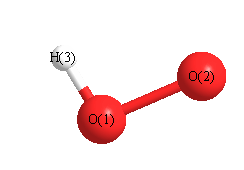.
| squib |
reference |
DOI |
| 1982Cha/Del:426 |
Charo, A.; De Lucia, F. "The Millimeter and Submillimter Spectrum of HO2: The Effects of Unpaired Electronic Spin in a Light Asymmetric Rotor." Journal of Molecular Spectroscopy. 94, 426-436 (1982) |
10.1016/0022-2852(82)90018-2 |
| 1984Lub/Ama:4826 |
KG Lubic, T Amano, H Uehara, K Kawaguchi, E Hirota :The nu1 band of the DO2 radical by difference frequency laser and diode laser spectroscopy: The equilibrium sturcture of the hydroperoxyl radical" J. Chem. Phys. 81, 4826, 1984 |
10.1063/1.447508 |
| 2002Rie/Tsc:231 |
JC Rienstra-Kiracofe, GS Tschumper, HF Schaefer III, S Nandi, GB Ellison "Atomic and Molecular Electron Affinities: Photoelectron Experiments and Theoretical Computations" Chemical Reviews 2002, 102, 231-282 |
10.1021/cr990044u |
| 2006Rus/Pin:6592 |
B Ruscic, RE Pinzon, ML Morton, NK Srinivasan, M-C Su, JW Sutherland, JV Michael "Active Thermochemical Tables: Accurate Enthalpy of Formation of Hydroperoxyl Radical, HO2" J. Phys. Chem. A 2006, 110, 6592-6601 |
10.1021/jp056311j |
| Gurvich |
Gurvich, L.V.; Veyts, I. V.; Alcock, C. B., Thermodynamic Properties of Individual Substances, Fouth Edition, Hemisphere Pub. Co., New York, 1989 |
|
| VEEL5 |
M.E. Jacox, Vibrational and Electronic Energy Levels of Polyatomic Transient Molecules, J. Phys. Chem.Ref. Data, Monograph 3 (1994) (updated data in NIST Chemistry Webbook - http://webbook.nist.gov/chemistry/ |
|
| webbook |
NIST Chemistry Webbook (http://webbook.nist.gov/chemistry) |
10.18434/T4D303 |











